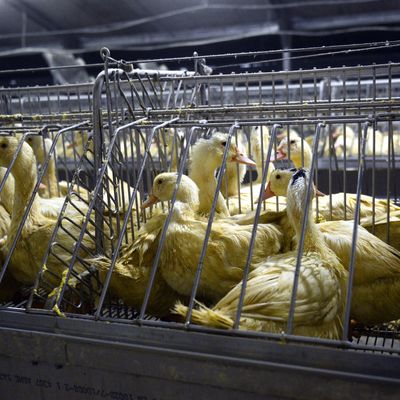
Have animal-rights activists finally succeeded in turning public opinion against foie gras producers? Between the release of footage depicting instances of animal suffering and several top chefs publicly dropping their foie suppliers, the luxury item seems to be having a tough PR moment, especially in France where it’s most beloved. This week, Marie-Pierre Pe, delegate general for France’s association of foie gras producers (CIFOG), begrudgingly conceded the point to the AFP. “Maybe we did go a little too far,” she said. “In the eighties, 30 to 35 percent of foie gras came from Eastern European countries. We had to improve production to be more competitive and maybe went too far.”
As spokesperson for the often controversial trade, Pe has constantly been put in the tricky position of relating the unavoidable details of gavage — a tube inserted into a duck or goose’s throat to deliver massive amounts of liver-engorging corn — to the public. “It is something natural; web-footed animals overeat to store fat before migration,” she told the Chicago Tribune back in 1994. When California moved to ban foie gras in 2012, Pe claimed the ruling violated WTO agreements and once again reiterated the foundational premise of foie gras production, that gavage on its own is not tantamount to animal suffering. By then, more people around the world were eating foie gras and the argument had been refined. “Since we respect the physiology of the animal, we cannot just let this go without reacting,” she said. “It’s a question of cultural shock,” Pe added on another occasion last year. “Could you imagine France banning ketchup or hamburgers?”
This week, the industry has seemingly taken a page from a crisis-communications handbook, and has changed the message yet again. “Of course gavage is not very romantic and so we avoided talking about it,” Pe said. “But now we are trying to explain it more and more.” Separately, she accused activists of “misinformation,” and even accused L214, the activists group that uploaded the video of injured and dead birds online, of dramatizing suffering. In addition to the real talk about gavage, CIFOG has increased transparency efforts, providing behind-the-scenes looks at farms where the ducks roam free and are force-fed only fifteen days during their lifespan.
It’s is a critical moment for the industry, as sales of foie gras surge throughout France during the holidays. Eating foie remains a delicacy, so foie remains an industry, and a matter of national pride. Within this context, the comment “maybe we did go a little too far” is more about national identity and less about animal welfare. It’s an overture to, for example, convincing retailers like Amazon to relist foie gras products on its U.K. sites.
As the AFP notes, not all of some 5,000 farms in France are small operations, and experts say that cameras inside any of these factory-style feedlots will no doubt continue to capture graphic images. “Force feeding is no more shocking than any other method of animal husbandry,” says researcher Xavier Fernandez. “The real question eventually is whether we should be rearing animals for human consumption at all?”
Outcry forces foie gras industry to swallow changes [AFP]
Saviez-vous que le foie gras est le viagra du commerce extérieur français de fin d’année ? [Atlantico]
Earlier: Ramsay, Ducasse, More Top Chefs Called to Abandon Foie Gras After Cruelty Footage Leaks
Earlier: Animal Rights Group Persuades Joël Robuchon to Drop Controversial Foie Gras Supplier




